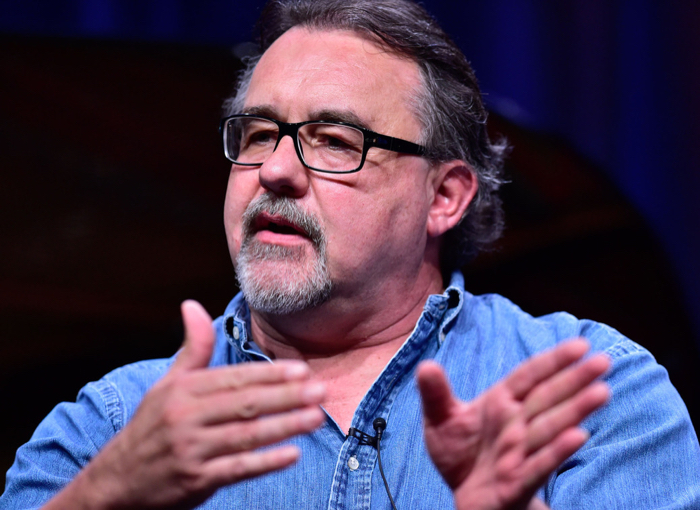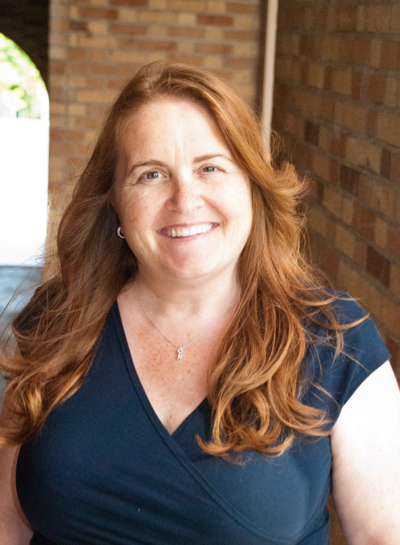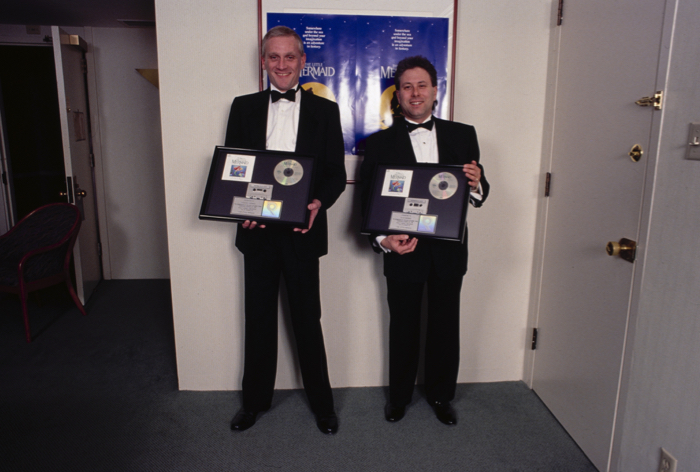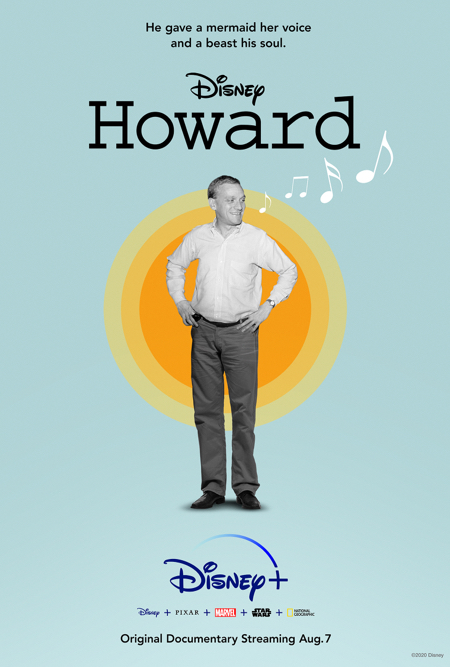Interview: “Howard” Writer, Director & Producer Don Hahn & Co-Producer Lori Korngiebel Talk Howard Ashman Documentary
Hi everyone!
I had the opportunity to interview the multi-talented Howard producer, director & writer, Don Hahn & co-producer Lori Korngiebel on Zoom yesterday. Howard is an emotional and powerful film about the life and work of Disney Legend and lyricist Howard Ashman, who died at age 40 from AIDS in 1991. I reviewed the film here. The last time I interviewed Hahn was in 2017 for the live-action Beauty and the Beast, where we talked briefly about Howard Ashman. At that time, Hahn said, “I could sit and talk for an hour about Howard and his gift for storytelling and putting plot into songs, and being able to dramatize things through music. He was a genius. He was really a genius and one of the most amazing people I’ve ever worked with.”. Fast forward to 2020 and Hahn gets to share Howard Ashman with millions of people through his documentary on Disney+.

Don Hahn. All photos copyright Disney.
Hahn has a wide body of work that includes animated films, live-action films and documentaries. He actually has more documentaries than I knew about, but they include the wonderful Waking Sleeping Beauty as well as Disneynature films.
One thing I had taken note of at the end of Howard was Ashman singing a song that almost never made it into The Little Mermaid, “Part of Your World”. He fought to keep the song in to the point where it nearly had him fired. It also seemed a perfect metaphor for his life as photos of Ashman are shown. Honestly, I can’t get through the credits without tears. Hahn said, “For some reason, that song…the introduction to it and the way it starts out…when you hear those notes that Alan plays, it’s always so goosebump-y.” Hahn also said he wanted to hear Howard sing over the credits. “To hear actually, how close he was to the final performance that Ariel gave. He really directed, not just with his words but with his performance”. Korngiebel added, “That was one of the last things we did…you’re in a situation where we just told Howard’s story from Howard’s point of view, and it just felt appropriate to end hearing Howard because it’s his movie. Don always wanted Howard’s voice to shine through in the film. That was one of the demos we had of him…it was beautiful and it fit perfectly. I cry every time I hear it”.

Lori Korngiebel
Another aspect I found interesting in Howard was that we never see anyone in the present day. Almost all footage is from the timespan of Howard Ashman’s life, which really grounds the documentary in the 40 years from the 1950s – early 90s. I asked them about this. Hahn and Korngiebel laughed, and Hahn said, “The real answer – and you’ll think that I’m joking – is look at us 30 years ago and look at us now. That’s the honest, honest answer (still laughing). If you had the choice between us today or 30 years ago, you might choose 30 years ago because we were young and beautiful.” He became more serious and said, “And that is part of it, and the other part is…we did have new footage, and this is something we began discovering on Waking Sleeping Beauty…it’s beautiful, it’s high resolution…4K, there’s lights, there’s hair, there’s makeup and all this stuff. And then you cut to this scratchy VHS, grainy stuff that we were finding in the archives. It just took you out of the movie to cut to the high definition material. So you’re in the moment, you are there in the 80s…you’re there with Howard, you’re there in a recording session with Angela Lansbury – and then to cut to Don Hahn saying something, it would be like, (laughing)…that’s so out of the moment”.
I asked Hahn how he met Ashman. “I met him in New York for the first time because we were working on Beauty and the Beast, and it was falling apart story-wise. And Howard was living in New York. Mermaid was just coming out, so we went to him and asked him if he’d be part of working on Beauty and the Beast. So I think that is the first time I met him, we had a roundtable discussion with Howard and Alan (Menken) and Kirk Wise and Gary Trousdale, and Linda Wolverton. And we tried to pull Howard into that project for the first time.

There is a scene in Howard that I’ve watched many times, and it is the “Be Our Guest” segment with Howard and Alan, Angela Lansbury and the late Jerry Orbach and others. I hate the word “scene” for it, because it is like looking through a window into a room 30 years ago – just real life, as the film was being created. It is both joyful and poignant as there are some in the room who do know Ashman had AIDS, including Alan Menken. Hahn says about that, ”Boy…,dispassionately looking at it, we were fortunate because…it’s a good scene because two things were happening at once. On one level, half the characters in the room know what is really going on, that Howard is sick. And the other half are just doing their jobs, just trying to create a really interesting song. So it’s a real working session, everyone’s got their sleeves rolled up. The orchestra is there, everyone’s joking. But it’s like a Hitchcock movie where there’s a stick of dynamite under the dining room table and everyone’s having this nice dinner and nobody knows there’s dynamite under the table…and it’s a wonderful, cinematic kind of idea. I think that is what makes it so bittersweet…you, as an audience know what is going on. And it’s also fun for the audience to get to see those moments.” He also mentions working on the Beauty and the Beast Sing-A-Long at Epcot with Angela Lansbury. Korngiebel continued, “How great is it to have Mrs. Potts talking about if you want to know anything about tea as Angela Lansbury is having that sidebar conversation.” Hahn said that it was an EPK crew filming and that it was “dumb luck” to have the footage they do have.
The documentary is almost exactly half pre-Disney and then the other half is Ashman’s life and work during the Disney years. I asked how they decided what to put into the film in the earlier years. Hahn said, “We started out in the Library of Congress and kind of went through his archives, and spent a couple of days in D.C.”. They then went to his sister Sarah’s house. Korngiebel continued, “A lot had to do with what we had. The Library of Congress was a treasure trove, and how lucky were we that that’s where Howard’s archives went. So Don and I would sit at different tables, going through different boxes and one of us would excitedly look at the other and say, ‘I found treasure!’ as we’re scanning things and taking photos. And then we were lucky enough to be invited up to Sarah’s house. She opened up her family albums as if we were family….at one point, her cat was sitting on Don’s shoulder as we were looking through family albums (laughing).” Koengiebel also said about how it being the 1970s and 80s, there were limitations on what was available. It isn’t like now where recordings and photos are commonplace, and she mentions how tape from the 70s and 80s may have disinegrated. “The pace of the movie, a lot of times, was dictated by what we had, and what kind of storytelling we could do.”

Howard Ashman and Alan Menken
One example of the storytelling that could have not been available was the Magic Kingdom scene. “Don knew that Howard was at Walt Disney World for The Little Mermaid press junket. And we called everyone, every radio station, television station from Orlando…nobody had anything. That audio tape came to Don at the 11th hour…literally a friend saying, ‘Hey, a friend of mine was at that session and found an audio cassette’. So the found objects in this movie were often miraculous”. Hahn said they were “blessed” to have people who would give them material.
I asked how the film came to be. Hahn said he knew for years that there was a USC student, who as a grad student wanted to make a Howard Ashman documentary. Hahn knew this from Ashman’s sister Sarah. Due to whatever reason, he abandoned the project and that was 20 years ago. “About five years ago I had lunch with Nancy Parent and Sarah, I was having a burger and halfway through lunch I blurted out in the most awkward way, ‘I think I’m going to make a documentary about Howard!’, laughing. “It was such an impulse.” Hahn said it became an obsession and he started getting everyone onboard with it. “I think we did it because we couldn’t not do it”.
I said to Hahn and Korngiebel what a perfect time this was, with Disney+ launching last year to have this new (and popular) platform to share the documentary on. Hahn said, “It is. Had we not had Disney+, we would have sent it out to 20 different film festivals. It would have done fine, won awards and whatever, and ended up with a limited theatrical release somewhere. But with Disney+, 60 million people subscribe to the service.” He said he’s done interviews all over the world about Howard’s story, and calls it gratifying.

Hahn said the last day he visited Ashman was different than in the movie because there is no footage to describe his passing, and they used symbolism to communicate that (including rain on windows). “In reality, we had a press conference that day for Beauty and the Beast. We had a really good reaction. And so, I went with Jeffrey Katzenberg and David Geffen and Peter Schneider to the hospital. There were always quite a few people around, because Howard was loved. By that time he had lost his sight, he didn’t really have much of a voice. And he was wearing his Beauty and the Beast sweatshirt, which was so sweet because I had sent him the sweatshirt months ago. It has a little Beauty and the Beast logo, I still have mine. I think of Howard everytime I see it. His mom was there, and his sister was there. I think Jodi was there too…Jodi Benson. I think we talked a little bit with each other…and then when we went to leave, each of us got to bend over and whisper into his ear and say our goodbyes, really. I’ve never been through anything like that.” He talks about having loss in his life, but Howard Ashman was just 39. “He was so optimistic, he was so happy we were there.”
Hahn said they didn’t want to make the film a pity party, because that wasn’t Howard’s life. “His sister once said, he had a really joyful life, a funny life, an interesting life. But it had a tragic ending. That was always in the back of our minds while we were making this”.
I said to Hahn that the film was a love letter to Ashman, both to his life and work, which were intermingled. Hahn replied, “Isn’t that the truth? I think that’s so interesting, because whether you’re an artist or whoever you are, your life and work are one. We often don’t see it that way. I don’t think of my life and my work as beng one. I have my home life and my work. Inevitably they’re inseparable. You put yourself into your work, and Howard did. Not to the point of trying to send send messages or have political theater or anything, but just to the point of committing himself to his work…Peter Schneider said, ‘It’s all about empathy’. Howard wasn’t trying to put messages into Beauty and the Beast about the AIDS crisis, he was trying to make you relate to the Beast, who was cursed. So that kind of empathy that Howard had came across in his work. And his sense of humor came across in his work. And you really get a snapshot of who he was by just listening to these songs and then hearing him talk. We wanted Howard to tell his own story as much as possible”.
Thank you so much to Don Hahn & Lori Korngiebel for their generous time. I expect to have some of the interview soon on our Mousesteps Weekly show. There was some of the interview that didn’t make it into the article but I trimmed it some.
